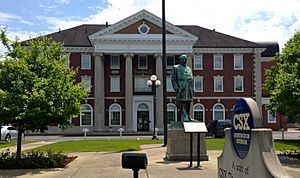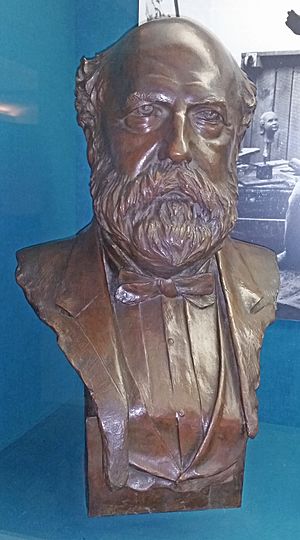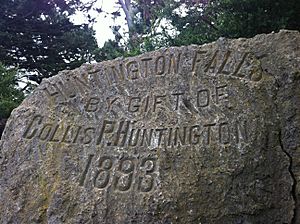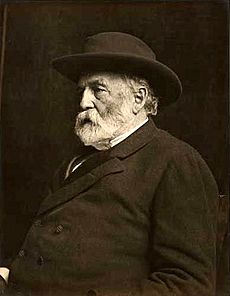Collis Potter Huntington facts for kids
Quick facts for kids
Collis Potter Huntington
|
|
|---|---|

Collis P. Huntington, c.1872 by Stephen W. Shaw
|
|
| Born | October 22, 1821 Harwinton, Connecticut, U.S.
|
| Died | August 13, 1900 (aged 78) Camp Pine Knot, Raquette Lake, New York
|
| Resting place | Woodlawn Cemetery, Bronx, New York |
| Nationality | American |
| Employer | Central Pacific Railroad Southern Pacific Railroad Chesapeake & Ohio Railway |
| Known for | First Transcontinental Railroad |
| Spouse(s) |
Elizabeth Stillman Stoddard
(m. 1844; died 1883)Arabella Huntington
(m. 1884) |
| Signature | |
Collis Potter Huntington (October 22, 1821 – August 13, 1900) was an important American businessman. He was a leader in building railroads. He was one of the "Big Four" who helped create the first transcontinental railroad in the U.S. This huge project connected the East and West coasts by train.
Huntington also helped build other major railroads. These included the Southern Pacific Railroad and the Chesapeake & Ohio Railway (C&O). The C&O line, finished in 1873, linked Richmond to the Ohio River Valley. A new city, Huntington, West Virginia, was named after him because of his work there.
Later, Huntington helped extend the C&O line to Hampton Roads in Virginia. This allowed West Virginia bituminous coal to be shipped out by sea. He also started the Newport News Shipbuilding and Drydock Company. This company helped create the new independent city of Newport News, Virginia. After he died, his nephew Henry E. Huntington and stepson Archer M. Huntington continued his work. They are all seen as important founders of the Newport News community.
Many of the railroad and industrial projects Huntington started are still important today. The Southern Pacific is now part of Union Pacific Railroad. The C&O became part of CSX Transportation. Both are big U.S. railroad systems. Coal from West Virginia is still sent by train to Hampton Roads. The large shipyard at Newport News is now run by Huntington Ingalls Industries.
Huntington was also active in politics. He worked in Washington, D.C., to support the Central Pacific and Southern Pacific railroads. He was known for his strong efforts to influence politicians. Some of his actions caused public concern in the 1880s. This made him a controversial figure in the railroad industry.
Huntington defended his actions, saying:
The motives back of my actions have been honest ones and results have redounded far more to the benefit of California than they have to my own.
In 1968, Collis Huntington was honored. He was added to the Hall of Great Westerners at the National Cowboy & Western Heritage Museum.
Contents
Life Story
Early Life and Work
Collis Potter Huntington was born on October 22, 1821. His family lived on a farm in Harwinton, Connecticut. He helped with farm chores and saved money from odd jobs. When he was 16, he started traveling as a salesman. During his travels, he saw the potential of Newport News Point in Virginia. This area was where the James River met the large harbor of Hampton Roads.
In 1842, he and his brother Solon started a successful business. They sold general goods in Oneonta, New York, until about 1848.
Huntington then saw a chance for success in America's West. He moved to California during the California Gold Rush. He became a merchant in Sacramento. He sold supplies and hardware to miners. He partnered with Mark Hopkins, and their business did very well.
Building the First U.S. Transcontinental Railroad
In the late 1850s, Huntington, Hopkins, Leland Stanford, and Charles Crocker had a big idea. They wanted to build a railroad that would connect the East and West coasts of America. In 1861, these four businessmen, known as The Big Four, combined their money and skills. They formed the Central Pacific Railroad company. This company would build the western part of the First Transcontinental Railroad. Huntington was known for being very determined in business.
Huntington worked in Washington, D.C., to make sure the railroad project moved forward. He negotiated with Grenville M. Dodge, who was in charge of building the railroad from the East. They agreed that the two railroad lines would meet at Promontory Summit, Utah. On May 10, 1869, the Central Pacific Railroad tracks joined with the Union Pacific Railroad tracks. This moment completed America's first transcontinental railroad. The event was celebrated by driving a special golden spike.
Southern Pacific Railroad

Starting in 1865, Huntington also helped create the Southern Pacific Railroad. This was another project with the Big Four partners. The first train engine for this railroad was named C. P. Huntington in his honor. The Southern Pacific grew to have over 9,000 miles of track. It connected New Orleans to the Southwest and California. It also controlled many steamship lines.
Chesapeake and Ohio Railway and New Cities
After the American Civil War, people in Virginia wanted to connect Richmond to the Ohio River Valley by rail. Williams Carter Wickham, president of the Virginia Central Railroad, needed money to rebuild. He convinced Collis Huntington to help finish the line.
Starting in 1871, Huntington oversaw the completion of the new Chesapeake and Ohio Railway (C&O). This line went from Richmond through Virginia and West Virginia to the Ohio River. There, he helped create the planned city of Huntington, West Virginia. He also worked to develop the bituminous coal business in southern West Virginia for the C&O.
Huntington had been buying land in Virginia's eastern Tidewater region since 1865. In 1880, he formed the Old Dominion Land Company. He gave his land holdings to this company.
In December 1880, he began building the C&O's Peninsula Subdivision. This line extended from Richmond down the Virginia Peninsula to Hampton Roads. New coal piers were built at Newport News Point. This allowed coal to be shipped out by sea.
The railroad construction moved very quickly. Work started from both Newport News and Richmond. The crews met near Williamsburg on October 16, 1881. Just three days later, on October 19, the first passenger train went to Yorktown. This was for the celebration of the 100th anniversary of the end of the American Revolutionary War there.
Soon after, the C&O's Hampton Branch was built. This line went towards Hampton and Old Point Comfort. It served popular hotels and later, Buckroe Beach amusement park.
At Newport News Point, Huntington also built the Hotel Warwick. He founded the Newport News Shipbuilding and Drydock Company. This became the largest privately owned shipyard in the United States. Huntington's vision and projects helped Newport News grow rapidly. It became a new independent city in 1896.
Huntington also supported education. He helped Hampton University, a school for African Americans, which was led by General Samuel C. Armstrong. One of Armstrong's famous students was Booker T. Washington. Huntington even provided a private train car for General Armstrong when he became ill.
The Huntington family and their Old Dominion Land Company made many contributions to the area. They helped establish schools, museums, libraries, and parks. In Williamsburg, Huntington's land company owned the historic site of the 18th-century capital buildings. This site later became a key part of Colonial Williamsburg, a major tourist attraction.
Huntington also supported his namesake city in West Virginia. He was a major investor in the Ensign Manufacturing Company. This company made freight cars for his railroads.
After Collis Huntington died in 1900, his nephew, Henry E. Huntington (1850-1927), took over many of his businesses. Henry sold off the Southern Pacific holdings. He and other family members also continued and expanded the family's cultural and charity projects.
Death
Collis Huntington died on August 13, 1900, at his "camp" called Camp Pine Knot in the Adirondack Mountains. He is buried in a grand mausoleum at Woodlawn Cemetery in Bronx, New York.
Political Influence
Besides building railroads, Huntington was known for his political activities in Washington, D.C. and California. He was a key lobbyist for the Central Pacific and Southern Pacific railroads. His main goals were to prevent rival railroad routes from getting government support and to delay payments on government loans. He tried to delay payments for many years, which caused a lot of public debate in California. Although he did not succeed in canceling the loans, the Southern Pacific eventually paid them off in 1909.
Huntington's private letters, which became public in 1883, showed his strong efforts to influence government officials. These letters revealed his determination to promote his companies' interests. While they caused controversy, they also showed his strong business sense and ability to handle big challenges.
One historian described him as:
...disposed to resist the idea that his railroad enterprises were to any degree burdened with public obligations. There is, on the other hand, no question with respect to his indomitable energy, his shrewdness in negotiation, his independence of thought and raciness of expression, and his grasp of large business problems. He was the dominant spirit among the small group of men who built up the Southern Pacific system, and that great organization remains his monument.
Family

Collis Huntington was born to William and Elizabeth (Vincent) Huntington. He had several siblings.
He married Elizabeth Stillman Stoddard on September 16, 1844. She died in 1883. They adopted her niece, Clara Elizabeth Prentice. Clara later married Prince Franz Edmund Joseph Gabriel Vitus von Hatzfeldt-Wildenburg from Germany.
Huntington married again on July 12, 1884, to Arabella D. Worsham. She had a son from her first marriage, Archer Milton Worsham. Huntington adopted Archer, who became known as Archer M. Huntington.
Archer M. Huntington became famous for his interest in Spanish and Portuguese culture. He founded The Hispanic Society of America, a museum and library in New York City. Archer and his second wife, sculptor Anna Hyatt Huntington, also created Brookgreen Gardens in South Carolina. He also founded the Mariners' Museum in Newport News, which is one of the largest of its kind.
Collis Huntington's nephew, Henry E. Huntington (1850-1927), was also a railroad leader. He founded the Huntington Library, Art Collections and Botanical Gardens in San Marino, California. He was very active in Los Angeles, California, developing the Pacific Electric railway system.
Charity Work
Collis Huntington collected a large amount of art. He was known as one of the country's top art collectors. He left most of his art collection, worth about $3 million, to the Metropolitan Museum of Art in New York. He also left money to Hampton University (then Hampton Institute) and to the Chapin Home for the Aged.
Places Named After Him

Buildings
- Collis P. Huntington High School, Newport News, Virginia
- Huntington Hotel – San Francisco, California
- Huntington Free Library and Reading Room – Bronx, New York
- Collis P. Huntington Academic Building; Tuskegee University, Alabama (Destroyed in a fire)
- Huntington Dorm; Tuskegee University, Alabama
- Collis P. Huntington House, New York City
- C. P. Huntington Primary School in Sacramento, California
- Collis Potter and Howard Edwards Huntington Memorial Hospital in Pasadena, California
- Huntington Hall – U.S. Navy enlisted housing and USO 3100 Huntington Avenue, Newport News, Virginia
- Collis P. Huntington Memorial Library – Hampton University Now, the Hampton University Museum, Hampton, Virginia
Cities and Neighborhoods
- Huntington, West Virginia
- Collis and Huntington Avenues in Huntington, West Virginia
- Huntington, Texas in Angelina County, Texas
- Huntingdon, Abbotsford, neighborhood in Abbotsford, British Columbia
- North End Huntington Heights Historic District, residential district in Newport News, Virginia
Other Places
- Camp Pine Knot, also known as Camp Huntington, on Raquette Lake, New York, now owned by the State University of New York at Cortland
- Collis P. Huntington State Park, Redding and Bethel, Connecticut
- Huntington Park, and Huntington Avenue, Newport News, Virginia
- Huntington Park, the site of his San Francisco home that was destroyed by the 1906 earthquake and fire
- Mount Huntington, a peak in Fresno County, California
- Collis Place in Bronx County, New York, near Huntington's mansion.
- Tugboat Huntington – retired 1994, now an exhibit at the Palm Beach Maritime Museum, Palm Beach, Florida
- Collis Avenue, a residential street in Los Angeles and South Pasadena, California
- Huntington Boulevard in Fresno, California
- C.P. Huntington, a type of train engine currently owned by the California State Railroad Museum
Images for kids
See also
 In Spanish: Collis Potter Huntington para niños
In Spanish: Collis Potter Huntington para niños



